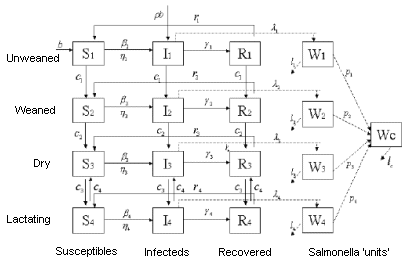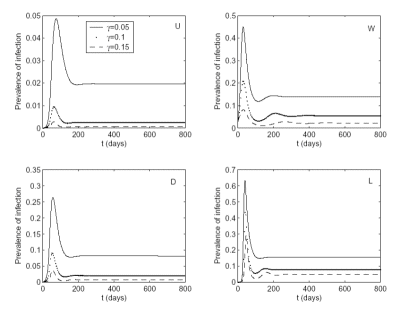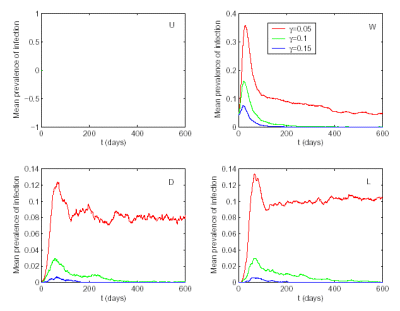The Model
The mathematical modelling work on Salmonella in cattle was based upon the four-group (four classifications of cattle) SIRS model seen in Figure 1. The parameters in this are defined as:
β, η - the direct and indirect transmission rates,
γ, r - the rate at which animals develop and lose protective immunity,
λ, p - the shedding and movement of the pathogen into the environment,
l - the death rate of the pathogen in the environment,
c, ρ - the movement of animals between groups and the birth rate.

Figure 1: A diagrammatic representation of the dairy herd model. The cattle are split into 12 groups, based on whether they are unweaned (1), weaned (2), dry (3) or lactating (4), and also whether they are either susceptible to (S), infected with (I) or immune to/recovered from (R) Salmonella.
Selected Results
The work looks at the effect on the prevalence of the (salmonella) infection when certain characteristics of the cattle are varied. For example, the pathogen induced mortality or persistence of the immune response. These were looked at using both deterministic and stochastic approaches. The results for when the infectious period of the Salmonella is varied are shown here.
Firstly taking a deterministic approach, the infection period to be either 20 days (γ=0.05), 10 days (γ=0.1) or 6 days (γ=0.15). The prevalence of infection, starting from a single (or low number of) initial infection (s), is plotted over time. This is shown, in Figure 2, for each group (eg. unweaned, weaned).

Figure 2: The prevalence over time for each of the four groups (unweaned, weaned, dry and lactating), where the infectious period is either 20 days (γ=0.05), 10 days (γ=0.1) or 6 days (γ=0.15), using a deterministic approach.
As the infectious period decreases, the initial outbreak size decreases, as does the (long-term) mean prevalence of infection (and hence the overall size of the epidemic decreases).
Taking a stochastic approach, again measuring the prevalence of infection for various infectious periods, the results gained are shown in Figure 3.

Figure 3: The prevalence over time for each of the four groups (unweaned, weaned, dry and lactating), where the infectious period is either 20 days (γ=0.05), 10 days (γ=0.1) or 6 days (γ=0.15), using a stochastic approach.
Again, as the infectious period decreases, the initial outbreak size decreases (as does the overall size of the epidemic). However, with the stochastic approach, there is also a greater probability of the infection dying out and, as γ increases, a reduction in the mean time this extiction takes (with smaller variations).
Similar results for both the deterministic and stochastic approaches were gained when other characteristics concerning infection were looked at. For example, higher pahogen induced mortality, more persistant immune response and more rapid removal of faeces.
|

